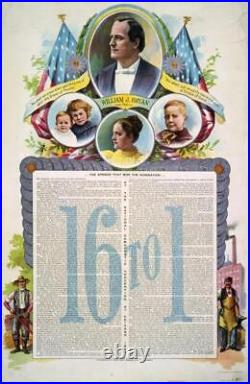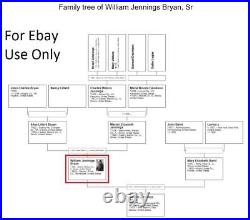20-2, 017-07, 1890s, Cabinet Card, William Jennings Bryan (1860-1925) Politician






Family Tree (see last image). William Jennings Bryan (March 19, 1860 - July 26, 1925) was an American lawyer, orator, and politician. Beginning in 1896, he emerged as a dominant force in the Democratic Party, running three times as the party's nominee for President of the United States in the 1896, 1900, and 1908 elections.
He served in the House of Representatives from 1891 to 1895 and as the Secretary of State under Woodrow Wilson from 1913 to 1915. Because of his faith in the wisdom of the common people, Bryan was often called "the Great Commoner", and because of his rhetorical power and early fame as the youngest presidential candidate, "the Boy Orator".Born and raised in Illinois, Bryan moved to Nebraska in the 1880s. He won election to the U.
House of Representatives in the 1890 elections, served two terms, and made an unsuccessful run for the U. At the 1896 Democratic National Convention, Bryan delivered his "Cross of Gold" speech which attacked the gold standard and the eastern moneyed interests and crusaded for inflationary policies built around the expanded coinage of silver coins. In a repudiation of incumbent President Grover Cleveland and his conservative Bourbon Democrats, the Democratic convention nominated Bryan for president, making Bryan the youngest major party presidential nominee in U. Subsequently, Bryan was also nominated for president by the left-wing Populist Party, and many Populists would eventually follow Bryan into the Democratic Party. In the intensely-fought 1896 presidential election, the Republican nominee, William McKinley, emerged triumphant. At age 36, Bryan remains the youngest person in United States history to receive an electoral vote for president and cumulatively, the most electoral votes without ever being elected president. Bryan gained fame as an orator, as he invented the national stumping tour when he reached an audience of 5 million people in 27 states in 1896, and continued to deliver well-attended lectures on the Chautauqua circuit well into the 20th century.From July 10 to 21, 1925, Bryan participated in the highly publicized Scopes Trial. Scopes, had violated the Butler Act, a Tennessee law barring the teaching of evolution in public schools, while serving as a substitute biology teacher in Dayton, Tennessee. His defense was funded by the American Civil Liberties Union and led in court by the famed lawyer Clarence Darrow. No one disputed that Scopes had violated the Butler Act, but Darrow argued that the statute violated the Establishment Clause of the First Amendment. Bryan defended the right of parents to choose what schools teach, argued that Darwinism was merely a "hypothesis", and claimed that Darrow and other intellectuals were trying to invalidate "every moral standard that the Bible gives us".
The defense called Bryan as a witness and asked him about his belief in the literal word of the Bible, though the judge later expunged Bryan's testimony. In the days following the Scopes Trial, Bryan delivered several speeches in Tennessee.
On Sunday, July 26, 1925, Bryan died in his sleep from apoplexy after he had attended a church service in Dayton. Bryan's body was transported by rail from Dayton to Washington, D.
He was buried at Arlington National Cemetery, with an epitaph that read, Statesman, yet Friend to Truth! Of Soul Sincere, in Action Faithful, and in Honor Clear" and on the other side "He Kept the Faith. Back is blank (with writing). The Standard Art Mfg Co.
142 W 23d Street, New York, NY. Card size: 4.25" x 6.5".
Was a style of photograph which was widely used for photographic portraiture after 1870. It consisted of a thin photograph mounted on a card typically measuring 108 by 165 mm (4+1? The carte de visite was displaced by the larger cabinet card in the 1880s.
In the early 1860s, both types of photographs were essentially the same in process and design. Both were most often albumen prints, the primary difference being the cabinet card was larger and usually included extensive logos and information on the reverse side of the card to advertise the photographer's services. However, later into its popularity, other types of papers began to replace the albumen process. Despite the similarity, the cabinet card format was initially used for landscape views before it was adopted for portraiture. Some cabinet card images from the 1890s have the appearance of a black-and-white photograph in contrast to the distinctive sepia toning notable in the albumen print process.
These photographs have a neutral image tone and were most likely produced on a matte collodion, gelatin or gelatin bromide paper. Sometimes images from this period can be identified by a greenish cast.Gelatin papers were introduced in the 1870s and started gaining acceptance in the 1880s and 1890s as the gelatin bromide papers became popular. Matte collodion was used in the same period.
A true black-and-white image on a cabinet card is likely to have been produced in the 1890s or after 1900. The last cabinet cards were produced in the 1920s, even as late as 1924. Owing to the larger image size, the cabinet card steadily increased in popularity during the second half of the 1860s and into the 1870s, replacing the carte de visite as the most popular form of portraiture. The cabinet card was large enough to be easily viewed from across the room when typically displayed on a cabinet, which is probably why they became known as such in the vernacular.Whatever the name, the popular print format joined the photograph album as a fixture in the late 19th-century Victorian parlor. Please see scans for actual condition. (images 3,4 & 5 are for reference only). This Cabinet Card would make a great addition to your collection or as a Gift (nice for Framing).
Newest Collections with FREE S&H. To see all my Postcards. To see all my Movie Items.
To see all my Disney Items. To see all my Baseball Items. To see all my Boy Scout Cards.
To see all my Stereoview Cards. Add me to your Favorite Sellers and Sign up for my Newsletter.
Ground Advantage (the old 1st class). Please look at my other Auctions for more Collectibles of the 1800's-1900's. Get Supersized Images & Free Image Hosting. Create your brand with Auctiva's.
Attention Sellers - Get Templates Image Hosting, Scheduling at Auctiva.
